Day 2 of a three day Private Tour today. We were planning to travel further afield, a day of twitching, to try to see some of the more unusual birds lingering around East Anglia at the moment. It was a cloudy but dry day, still very windy but thankfully not quite as strong as it was yesterday.
The drive down to Minsmere was a slow one this morning. We hit rush hour around Norwich, which was not too bad, but then were held up behind a Highways Agency van which seemed to just be trying to build up as large a queue of traffic as possible as it drove along very slowly with lights flashing. When it finally pulled over, there was no sign of what might have required that sort of action. A couple of Red Kites were the only highlights of the journey.
When we eventually got down to the reserve, we walked straight out to Bittern Hide. There has been a Purple Heron here for several days now, but it spends a lot of time down in the reedbed out of view. It had been seen about one and a half hours before we arrived, but nothing since. We sat down and prepared for a vigil.
There were other things to see while we waited. A female Marsh Harrier spent ages diving repeatedly at something hidden down in reeds. A Bittern had flown in and landed in that very spot earlier, before we arrived, which was probably what it was trying to chase off. Apparently the Marsh Harrier had a nest nearby. A smart male Marsh Harrier spent some time quartering over the reeds in front of the hide – unfortunately not close enough to flush the Purple Heron!
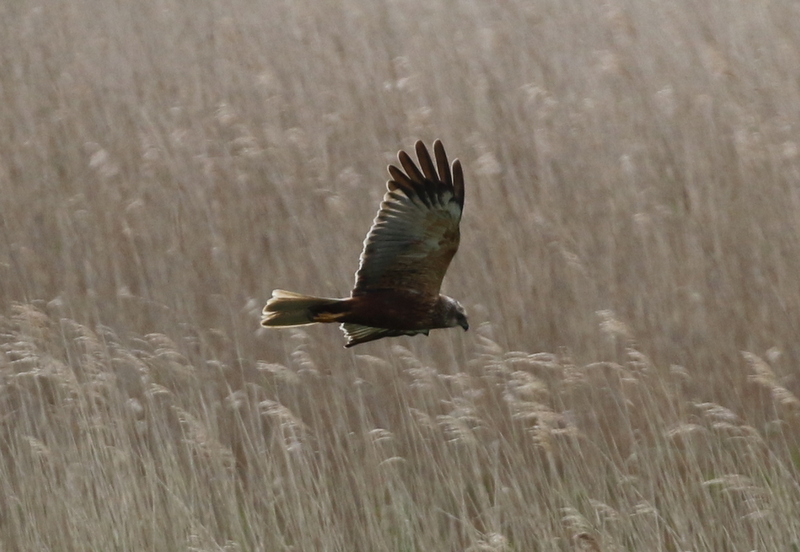 Marsh Harrier – quartering the reeds in front of the hide
Marsh Harrier – quartering the reeds in front of the hide
There were several reserve volunteers in the hide today, with radios and clipboards. It turned out they were doing a co-ordinated Bittern survey, which meant we were quickly alerted to any Bittern flights. We got a very brief glimpse of one at first, just as it dropped back in to the reeds. A little later, another Bittern came up and we watched it for several seconds as it flew from us away over the reeds.
A Grey Heron flew in and landed exactly where the Purple Heron was last seen, but even that didn’t flush it out. Several Little Egrets flew past, there were lots of Swifts and Sand Martins zipping back and forth over the reeds in the wind, and two Common Terns drifted past calling.
Finally the Purple Heron appeared – we only had to wait about an hour. It flew up briefly and dropped down again, behind the reeds in front of the hide, where we could just see its head. Then it was up again and off, in a long flight across over the reedbed, before dropping down over towards the main scrape hides. It was great to see it.
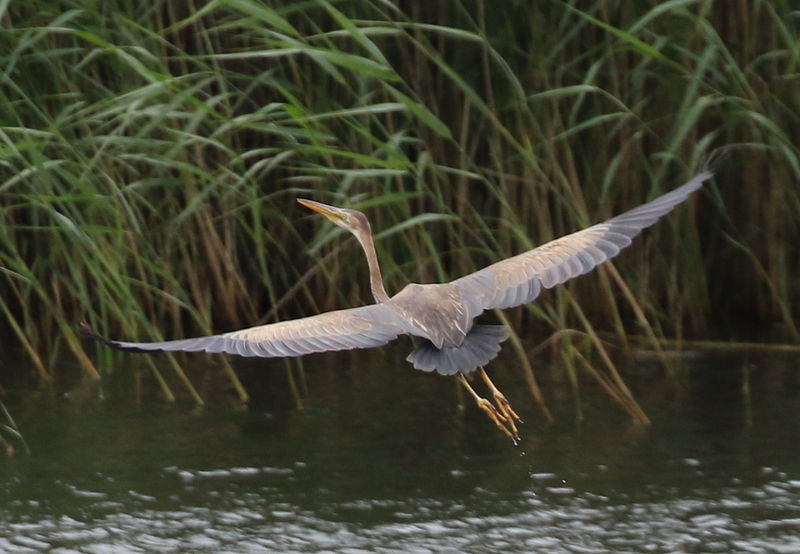
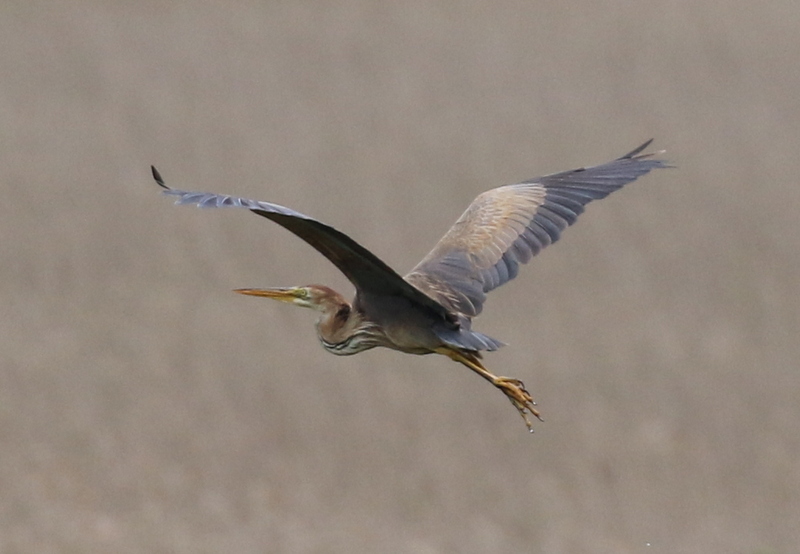 Purple Heron – finally came out of hiding and flew away over the reeds
Purple Heron – finally came out of hiding and flew away over the reeds
Purple Herons are rare visitors here from southern Europe. This is a young bird, a 1st summer, which has presumably overshot on its way north. It will probably drift round the UK for a while before making its way back to the continent.
It was time to move on, so we made our way round to the scrapes and the Wildlife Lookout. There were lots of gulls out on the islands in front of the hide. As well as lots of Black-headed Gulls there were plenty of Mediterranean Gulls too. Having got great views of them in flight over the last few days, it was nice to get a couple of birds in the scope on the ground today, admiring their jet black heads and white wing tips. Otherwise, there were just a few big gulls here, Herring Gulls and Lesser Black-backed Gulls.
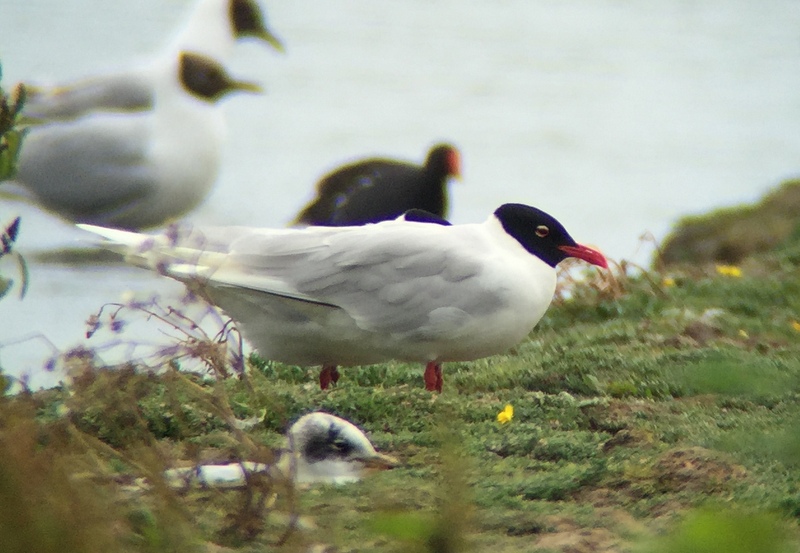 Mediterranean Gulls – nice to see some birds on the ground this time
Mediterranean Gulls – nice to see some birds on the ground this time
It looks like Minsmere is a good place for feral wildfowl these days. There were lots of feral Barnacle Geese on the scrapes – we saw several pairs with juveniles today, presumably having bred here. Another four more Barnacle Geese flew in calling. There had been a pair of feral Bar-headed Geese here yesterday with a single gosling, but we couldn’t find them today.
Apart from the gulls and the geese, there were just a few waders – Avocets and Lapwings – and a couple of Little Egrets. Unfortunately, we didn’t have time to explore the whole reserve today, we had other plans, so we made our way back towards the visitor centre. We took a quick detour round to see if we could see any Stone Curlew, but the vegetation was too high and no birds were out in view. That was really a target for tomorrow, so we didn’t stop here long.
As we made our way out of the reserve, we made a quick stop to to look at a mob of roosting gulls in a field. There were lots of Herring Gulls of various ages, plus a few Lesser Black-backed Gulls and one or two young Great Black-backed Gulls. The one interesting looking gull we could find was mostly hidden from view behind the throng, with its head down preening. It looked like a 1st summer Yellow-legged Gull, but before we could get a good look at it a Herring Gull landed in front and it sat down and was lost to view. We continued on our journey.
It was a slow journey back up to the Broads. We were heading for Potter Heigham, but news came through of a White-winged Black Tern on the beach at Winterton. It had actually been seen a couple of times flying past offshore in the morning, but had finally settled down on the sand with the Little Terns. We took a quick diversion down to the beach at Winterton, but when we got there, we found the White-winged Black Tern had been disturbed by dog walker and flown off south.
We had a late lunch on the beach, looking out to sea. A small raft of Common Scoter were diving offshore, and we could see a few distant Little Terns and Sandwich Terns. We thought about walking up the beach to the Little Tern colony to look anyway, but one of the local birders called another person who was up at the colony and it was confirmed there was still no sign of the White-winged Black Tern. We decided to revert to Plan A, and head for Potter Heigham. It was only later we found out that the White-winged Black Tern was relocated in the Little Tern colony just 5 minutes after we left, but then had flown off out to sea!!
It was our intention to visit Potter Heigham today anyway, as we knew there were some Black-winged Stilts nesting there. A rare but increasing visitor from southern Europe, their presence was being kept quiet to protect them from egg thieves. A quick phone call to check on them earlier this morning had revealed the eggs had hatched yesterday, so we were even keener to see them today. On our way there, the news was finally released that the Black-winged Stilts had successfully hatched 4 young and they were still all present and correct.
When we got to the site, we walked straight round to look for them. First we found a lone female Black-winged Stilt on one of the islands preening. Looking further back, there was the male Black-winged Stilt crouched on its knees. It took a bit of looking for them as they were so tiny and hard to see in the vegetation on the muddy island, but we eventually found the four tiny fluffy bundles, the four one day old juvenile Black-winged Stilts. A fantastic sight!
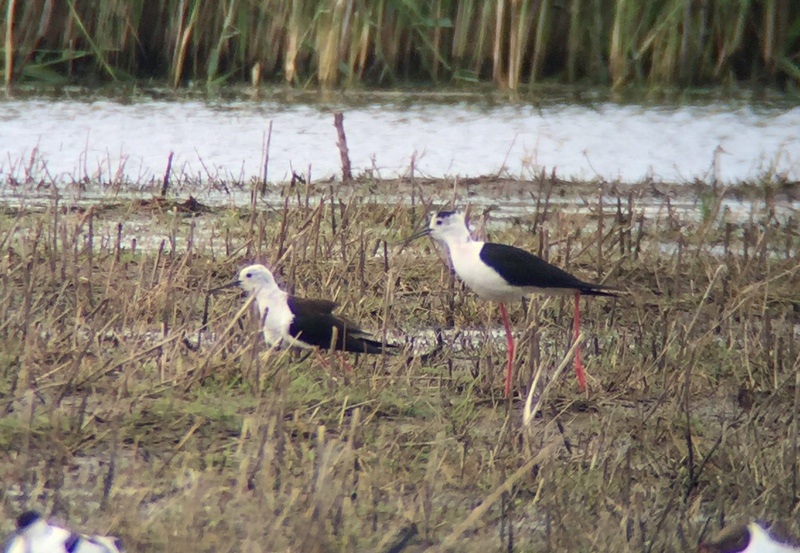 Black-winged Stilts – the proud parents, with the 4 juveniles hiding nearby
Black-winged Stilts – the proud parents, with the 4 juveniles hiding nearby
The adult Black-winged Stilts were largely ignoring the young ones, leaving them to wander some distance away among the nesting Black-headed Gulls. The adults would fly occasionally to chase off large gulls or any other potential predator flying over. Young Black-winged Stilts are very vulnerable to predation, so fingers crossed they survive.
Scanning across the scrape, we noticed another Black-winged Stilt nearby. Were there three adults? Unfortunately we never managed to see all of them at the same time, and the new bird was chased off by the male before we could see the female of the pair again. There had been two adults reported earlier, but it was only later, talking to another local birder, that we confirmed that he too had seen three adults and all at the same time.
We watched the Black-winged Stilts for a bit, before walking further up to check out the other pools. A Spoonbill was standing out on the mud by the reeds on one of them and for once it was awake! We got it in the scope and could see it was a young one, born last summer, with a still largely flesh-coloured bill and no crest.
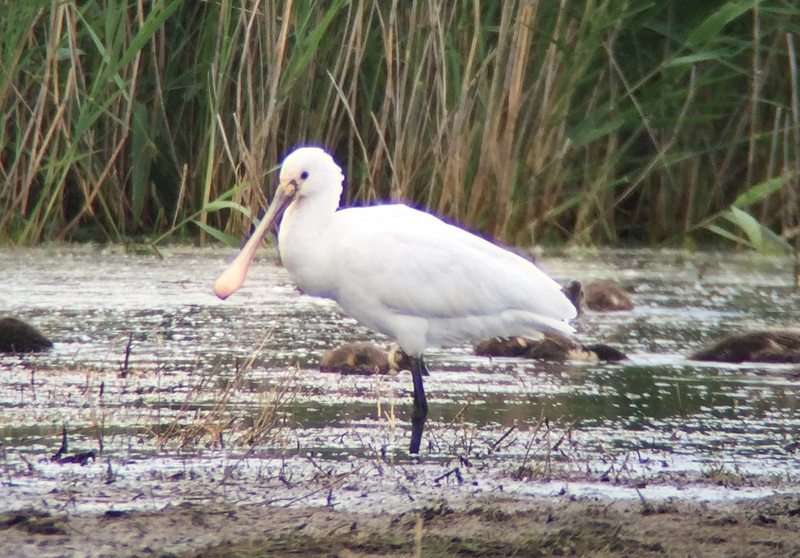 Spoonbill – a 1st summer bird on one of the pools
Spoonbill – a 1st summer bird on one of the pools
There were plenty of Little Egrets here too, but we couldn’t find the waders which had been reported yesterday. There were three Ringed Plovers on the mud and the usual Avocets, Lapwings and Redshank, but no other waders today (not forgetting the Stilts, of course!).
A Wigeon and a few Teal were the most notable ducks here. Otherwise, it was back to looking at escaped wildfowl. The female Bufflehead has been here for a while now, but is sporting a green ring so has got out from a cage somewhere. A White-cheeked Pintail was never a candidate for a genuine vagrant, unfortunately.
There were not many butterflies or dragonflies out in the wind today, but on the walk back to the car, a Norfolk Hawker dragonfly was flying around the bushes by the path. This is a particular speciality of this part of the country, so always nice to see. There were also numerous caterpillars out now, all crossing the path one way or the other. Most were Garden Tiger moth caterpillars, but there was also one Drinker moth caterpillar too.
 Garden Tiger moth caterpillar – there were loads on the path on the way back
Garden Tiger moth caterpillar – there were loads on the path on the way back
The other highlight of the walk back to the car was a Crane. We had scanned the marshes quickly on the walk out without success, but looked more carefully on the way back. It was looking like we might be out of luck until we picked one up flying low across the marshes in the distance. It gained height and flew past one of the old windpumps – a typical Broadland scene these days – before dropping down out of view again. Not a close view, but always nice to see anyway.
We had just stopped to scan the pools along the approach road when news came through that the White-winged Black Tern was back on the beach at Winterton. Even though it was getting late in the day and we would be cutting it fine to get back in time for dinner, we decided to head round for another go. It was a nervous drive round, after our experience earlier.
As we walked quickly up the beach, it was reassuring that there were not so many dog walkers out now. A couple of local birders were just walking back and kindly pointed the White-winged Black Tern out to us, quite a distance further up the beach in the Little Tern colony. We had a very quick look, before hurrying up to where it was. But before we got there, all the terns took off and we didn’t see the White-winged Black Tern go. When we arrived, there was no further sign of it at first.
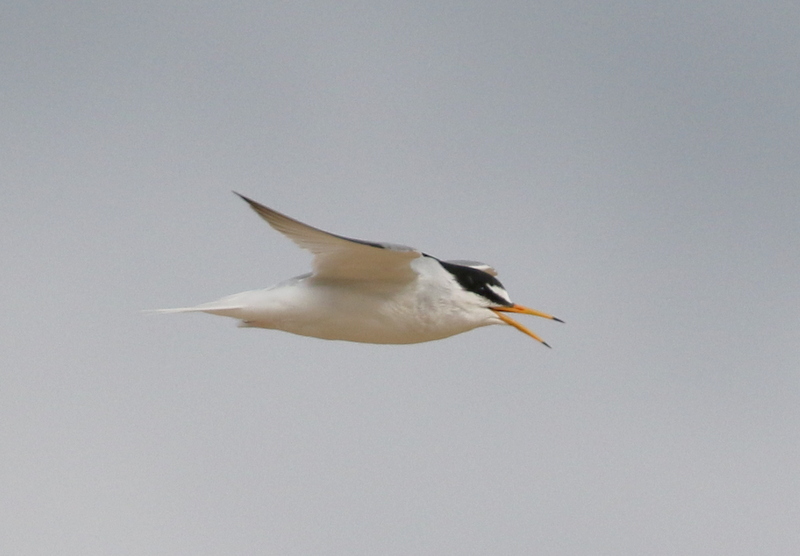 Little Tern – nice to see and hear all the terns in the colony here
Little Tern – nice to see and hear all the terns in the colony here
After our experience earlier, we were convinced the White-winged Black Tern would return, so we stood and waited, watching all the Little Terns coming and going as we did so. Thankfully after just a few nervous minutes scanning, we picked it up coming back in off the sea. We were then treated to stunning views as it flew all round us, circling overhead, before heading back out to the sea again.
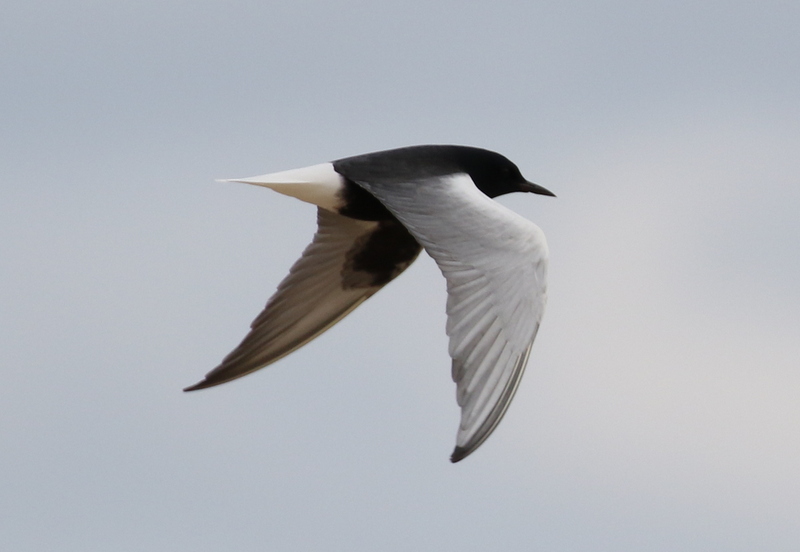
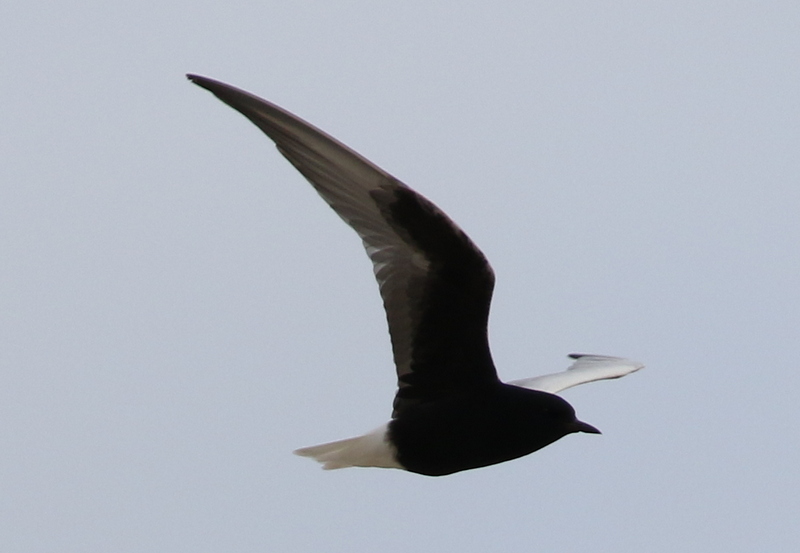
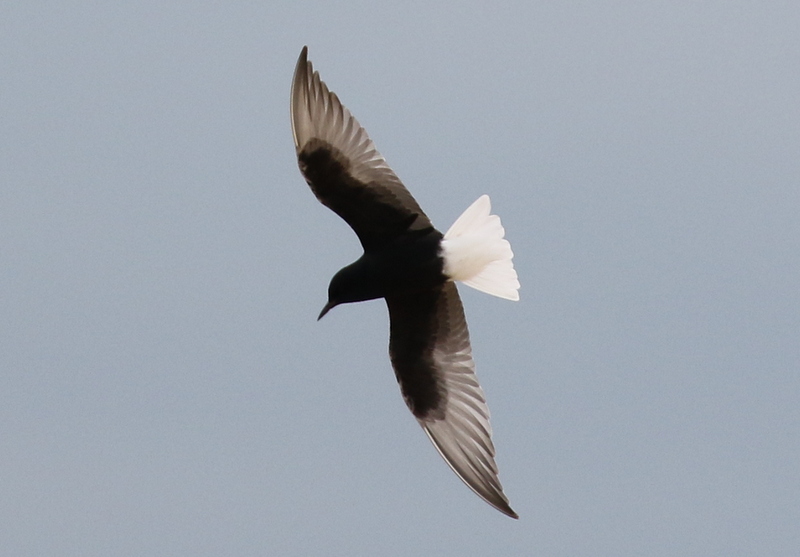 White-winged Black Tern – stunning views as it circled all around us
White-winged Black Tern – stunning views as it circled all around us
White-winged Black Tern is a rare visitor to the UK from Eastern Europe. A few are seen here every year, but they can be hard to catch up with and often don’t hang around, so this one was great to see. It was also an adult in full summer plumage, one of the most stunning of all terns.
Having had great views of it in flight, we wanted to see the White-winged Black Tern perched too. Thankfully we only had to wait a couple of minutes before it flew back in to the beach again and landed on the sand with a group of Little Terns. We got a great look at it as it stood there preening for a couple of minutes. Than it was off again, back out to the sea. We stood for a while watching it dip feeding just offshore, reluctant to tear ourselves away.
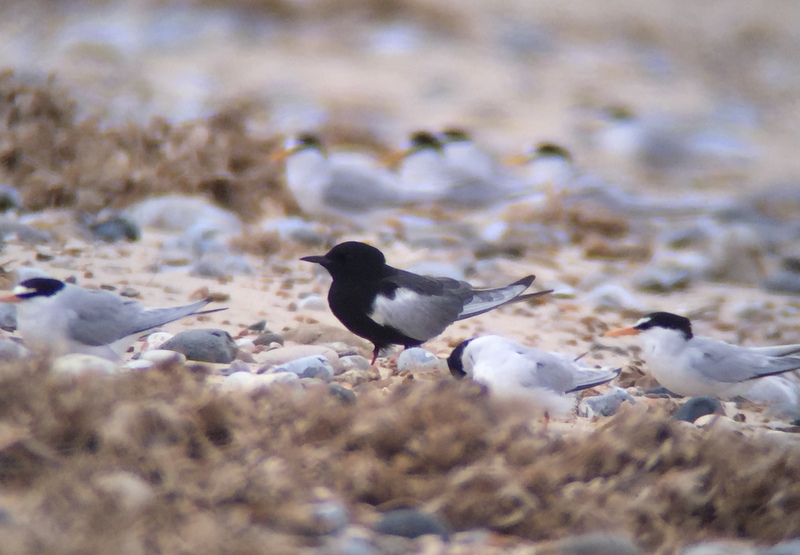 White-winged Black Tern – landed on the beach with all the Little Terns
White-winged Black Tern – landed on the beach with all the Little Terns
It was a great way to end the day, watching this fantastic bird. Eventually we made our way back to the car and headed for home. Even better, we were back in time for dinner, and we had seen the White-winged Black Tern!
















